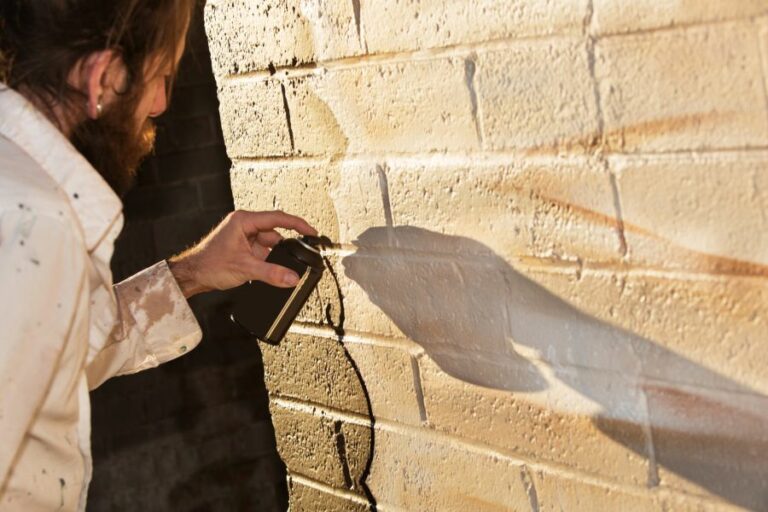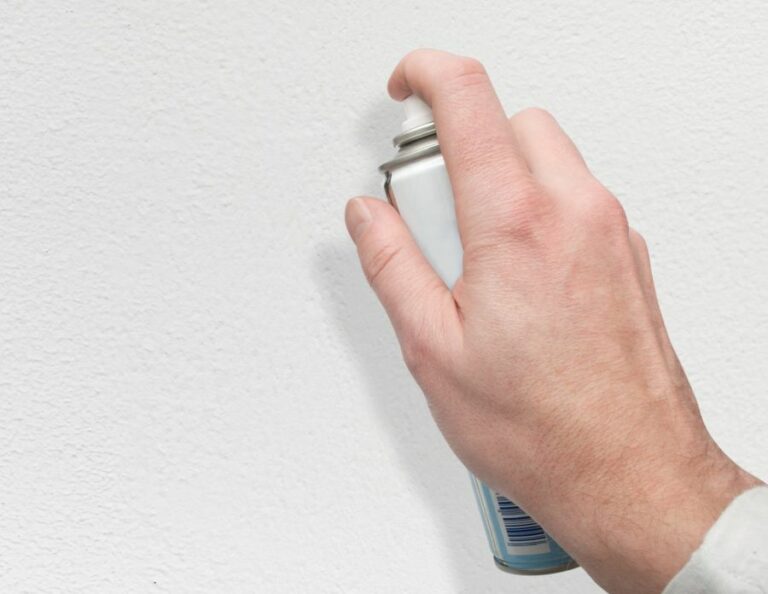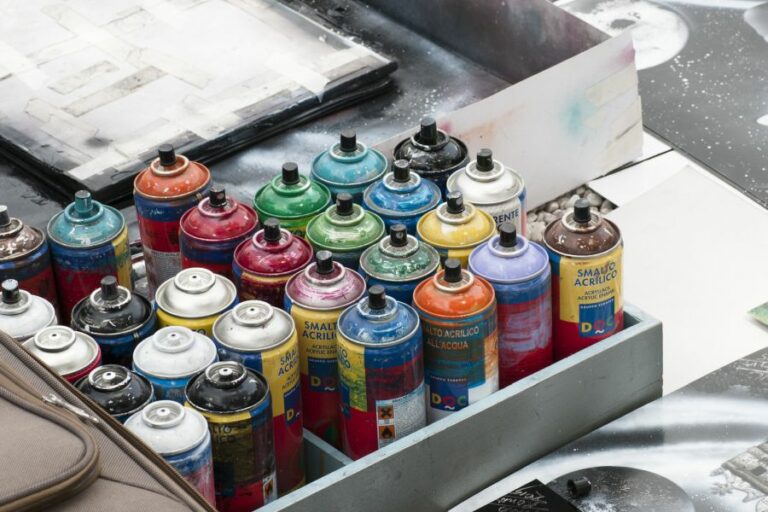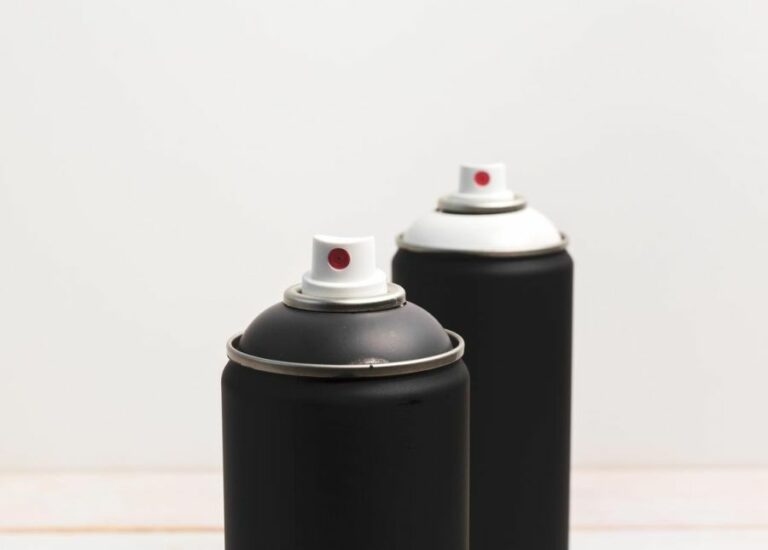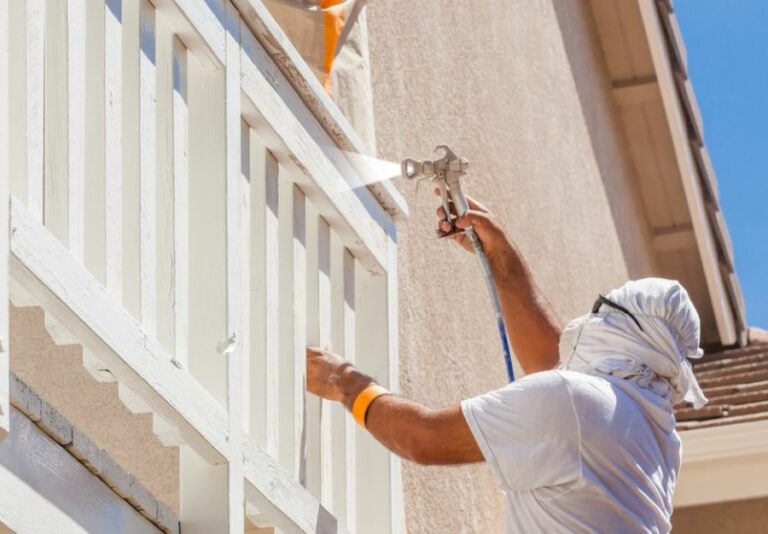Ways To Get Rid Of Spray Paint, Inside & Out. What Pros Say
Dealing with unwanted spray paint can be a daunting task, but don’t worry – we’ve got you covered with practical and effective methods to tackle the problem both indoors and outdoors. We’ll discuss essential tips and techniques that can help you remove spray paint from various surfaces, making it look brand new again. So, let’s dive in and explore the best ways to get rid of spray paint, inside and out.
Ways to get rid of spray paint, inside & out:
To remove spray paint indoors and outdoors, use paint thinner on brick, nail polish remover or fine steel wool on metal, a razor blade or nail polish remover on glass, sandpaper or paint stripper on wood, and paint stripper or a pressure washer on concrete. Always start with gentle methods and test chemicals on inconspicuous areas first.

Discover effective methods to remove spray paint from various surfaces both indoors and outdoors. Learn practical tips and tricks that make the process easy and efficient. There’s more to uncover, so read on and reclaim your surfaces from unwanted paint!
Contents
- 1 Methods for Removing Spray Paint Indoors & Outdoors
- 2 Duration of Spray Paint Fumes Indoors: A Guide
- 3 Can Spray Paint Odor Eventually Disappear?
- 4 Quick Solutions for Eliminating Paint Fumes Instantly
Methods for Removing Spray Paint Indoors & Outdoors
Spray paint can be a nuisance when it comes to unintended surfaces and areas. Whether it’s from a home improvement project gone awry or graffiti, removing it can be quite a chore. Luckily, there are numerous techniques to get rid of unwanted spray paint both inside and outside your home.
• Removing Spray Paint from Brick
One of the most challenging surfaces to remove spray paint from is brick. The porous nature of bricks allows the paint to penetrate the surface, making it difficult to clean up. Here are some methods to help you with this stubborn task:
– Using Paint Thinner
- First, test the paint thinner on an inconspicuous area to ensure it won’t damage your brick.
- Use a clean rag to apply the paint thinner generously to the spray paint.
- Allow the thinner to soak in for a few minutes before scrubbing with a stiff-bristle brush.
- Rinse the area with water to remove the remaining paint and thinner.
I recommend using safety goggles and gloves when handling paint thinner to protect your eyes and skin from irritation.
– Using Graffiti Removers
Several commercial graffiti removers are available, specifically designed for use on brick surfaces. Follow the manufacturer’s instructions on the product.
• Removing Spray Paint from Metal
Metal surfaces are generally more straightforward when it comes to removing spray paint. Here are some methods you can try:
– Using Nail Polish Remover
- Apply a small amount of nail polish remover (with acetone) to a clean rag.
- Gently rub the spray paint with the soaked rag.
- Rinse the area to remove any residue.
– Using Fine Steel Wool
- For more difficult paint, consider using fine steel wool with a bit of dish soap.
- Gently scrub the paint with the steel wool.
- Rinse the area to remove any residue.
• Removing Spray Paint from Glass
Accidentally getting spray paint on your windows or glass surface can be frustrating. Here are some ways to tackle this issue:
– Using a Razor Blade
- Carefully scrape the paint away with a razor blade or utility knife, ensuring not to scratch the glass.
- Clean the glass surface with a glass cleaner.
– Using Nail Polish Remover or Rubbing Alcohol
- Apply a small amount of nail polish remover (with acetone) or rubbing alcohol to a clean rag.
- Gently rub the spray paint with the soaked rag.
- Clean the glass surface with a glass cleaner.
• Removing Spray Paint from Wood
Wood surfaces can be tricky, as you need to remove the paint without damaging the wood’s finish. Here are some techniques you can try:
– Using Sandpaper
- If the wood is unfinished, start by sanding away the paint using fine-grit sandpaper.
- Clean the surface with a tack cloth or damp rag.
– Using Paint Stripper or Thinner
- Test the paint stripper or thinner on an inconspicuous area to ensure it won’t damage the wood finish.
- Follow the manufacturer’s instructions on applying the product.
- Gently scrape away the paint with a plastic scraper or putty knife.
– Using a Heat Gun
- Use a heat gun to soften the paint.
- Gently scrape away the paint with a plastic scraper or putty knife.
• Removing Spray Paint from Concrete
Concrete surfaces can be tricky because they are porous, just like brick. Here are some options for removing the paint:
- Using a paint stripper or cleaner designed for concrete surfaces. Follow the manufacturer’s instructions on the application.
- Using a pressure washer to blast away the paint. Keep the spray nozzle a safe distance from the surface to avoid damaging the concrete.
• Tips for Effective Spray Paint Removal
- Always start with the gentlest method and work your way to more aggressive approaches, following the specific recommendations provided in each section.
- Test any chemicals or abrasive materials on an inconspicuous area first to prevent any additional damage.
- Wear appropriate personal protective equipment, such as gloves and goggles, when using chemicals or abrasive materials.
- Consider seeking professional assistance if the paint is particularly stubborn or you are unsure how to proceed with the removal.
In conclusion, spray paint can be a headache when it ends up on unintended surfaces, but by using the techniques outlined in this article, you can successfully remove it and restore your surfaces to their proper state.
Duration of Spray Paint Fumes Indoors: A Guide
Spray paint fumes are a common concern when it comes to indoor painting, especially in poorly ventilated areas. These fumes can be harmful to both humans and animals.
• Components of Spray Paint Fumes
To understand the longevity of spray paint fumes, it is important to know their composition. The fumes contain volatile organic compounds (VOCs), which are chemicals that easily evaporate at room temperature. Examples of VOCs include acetone, xylene, and toluene, among others.
• Factors Influencing Fume Lifespan
The duration of spray paint fumes inside a space can depend on several factors. Some of the main factors include:
– Ventilation
Proper ventilation is crucial for reducing the concentration and longevity of spray paint fumes. Spaces with little to no air circulation will trap the fumes, causing them to linger for an extended period.
On the other hand, well-ventilated areas allow the fumes to dissipate quickly, typically within a few hours or days.
– Temperature and Humidity
High temperature and humidity levels can cause the paint to dry slower, prolonging the release of VOCs. Conversely, cooler and drier conditions help the paint dry quickly, thereby reducing the fume duration.
– The Type of Paint
Different types of spray paint have varying levels of VOCs. Low-VOC or water-based paints will emit fewer harmful fumes and are considered more environmentally friendly. In contrast, oil-based paints with high VOC content will produce stronger and longer-lasting fumes.
– Amount of Paint Used
Generally, the more paint is applied, the longer it will take to dry and the stronger the fumes will be. To minimize fume duration, it is essential to use spray paint sparingly and follow the manufacturer’s instructions for application and drying times.
• How Long Do Spray Paint Fumes Last?
Given the factors listed above, the longevity of spray paint fumes can vary significantly. However, in well-ventilated spaces with proper environmental conditions, fumes typically dissipate within a few hours or days. In contrast, poorly ventilated and high-humidity areas can cause fumes to linger for weeks, if not longer.
• How to Minimize Fume Effects
To reduce the impact of spray paint fumes on indoor air quality, consider the following recommendations:
– Choose Low-VOC Paints
As mentioned earlier, low-VOC or water-based paints produce fewer harmful fumes. Opting for such paints is an effective way to minimize the duration and intensity of the fumes.
– Increase Ventilation
Before you begin spray painting, ensure that the space is well-ventilated. Open windows and doors or use fans to maintain good airflow. Keep the ventilation system running throughout the painting process and for several days after. If possible, avoid staying in the room for long periods while the paint is drying.
– Wear Protective Equipment
Wearing the appropriate personal protective equipment (PPE), such as a respirator or mask, gloves, and goggles, can help minimize your exposure to fumes. These precautions are especially important when working with high-VOC paints or in poorly ventilated areas.
– Follow the Manufacturer’s Instructions
Adhere to the guidelines provided by the paint manufacturer for application, drying times, and cleanup. Taking shortcuts or improperly applying the paint can increase the duration and intensity of the fumes.
– Schedule Regular Breaks
If you must work in the painted area, take frequent breaks to reduce your exposure. Leave the room every 20-30 minutes to get fresh air and limit your overall time in the fume-filled environment.
• Conclusion
Spray paint fumes can pose risks to health and the environment. The longevity of these fumes depends on various factors like ventilation, temperature, humidity, paint type, and the amount used.
By choosing low-VOC paints, ensuring proper ventilation, wearing protective equipment, and following the recommended guidelines, you can significantly minimize the impact of spray paint fumes and maintain a safer indoor environment.
| How long do spray paint fumes last inside? | ||
|---|---|---|
| Factors | Description | Duration |
| Ventilation | How well-ventilated the area is | With good ventilation: a few hours; With poor ventilation: several days |
| Temperature and humidity | Higher temperatures and humidity levels speed up the paint-drying process | Hot and humid conditions: a few hours; Cold and dry conditions: several days |
| Type of paint | Water-based paints tend to have less fumes and dry faster, while oil-based paints can have stronger fumes and take longer to dry | Water-based paint: a few hours; Oil-based paint: several days |
| Size of the area | The size of the area being painted, as well as the amount of paint used | Large areas with more paint: several days; Small areas with less paint: hours to a day |
Can Spray Paint Odor Eventually Disappear?
While spray paint can be a useful tool for a variety of projects, it typically comes with an unpleasant odor. If you’ve recently used spray paint and are wondering, “Will the smell go away?” rest assured, it will eventually dissipate.
However, there are several factors that determine how long the smell will linger, and several methods can help speed up the process.
• Factors That Affect the Disappearance of Spray Paint Smell
– Type of Surface
The surface that has been spray painted will affect how long the odor persists. Porous materials like wood and fabric may retain the smell longer than non-porous surfaces like metal and glass.
– Amount of Paint Used
The more spray paint you use, the stronger and more persistent the smell will be. Large or multiple projects will likely contribute to a longer-lasting odor compared to a single, small project.
– Quality of Paint
Higher-quality spray paints usually contain fewer volatile organic compounds (VOCs), which are the primary source of the odor. Inexpensive or low-quality paints have higher VOC content, leading to a more intense and longer-lasting smell.
– Ventilation
The amount of ventilation in the room or area where the spray painting was carried out hugely impacts how quickly the smell dissipates. Proper ventilation helps dilute the VOCs in the air and facilitates faster evaporation, leading to a quicker reduction in odor.
• Tips to Make the Spray Paint Smell Go Away Faster
– Provide Adequate Ventilation
The most critical step to removing spray paint odor is to ensure the area is well-ventilated. Open all windows and doors, and use fans to create cross ventilation. This will help blow the fumes out of the room and bring in fresh air, speeding up the evaporation of VOCs.
Avoid being in the room without proper ventilation, as inhaling VOCs can cause health problems.
– Use Activated Charcoal
Activated charcoal is a powerful odor absorber. Place bowls of activated charcoal near the painted area, allowing the charcoal to absorb the VOCs and reduce the smell.
You can find activated charcoal at most pet stores, as it is commonly used in aquarium filters. Remember to replace the charcoal every few days for optimum results.
– Place Bowls of Vinegar or Baking Soda
Vinegar and baking soda are natural odor absorbers, and many individuals have these items in their homes already. Place shallow bowls of white vinegar or baking soda in the room with the spray paint smell.
The vinegar or baking soda will neutralize the odor, helping it dissipate more rapidly. Remember to replace the contents of the bowls every day or two for the best results.
– Use an Air Purifier
An air purifier equipped with a HEPA or carbon filter can help remove spray paint odors from the air. These filters are effective against VOCs and other air contaminants. Keep the air purifier running in the room until the smell is gone.
– Apply a Sealer
If the paint smell lingers even after using the above methods, consider applying a sealer on top of the painted surface. This will create a barrier, preventing the VOCs from continuing to evaporate and causing odor.
There are many types of sealers available, including polyurethane and clear acrylic; choose one based on your project’s needs.
• Precautions to Minimize Spray Paint Smell
– Choose Low-VOC Paint
Opt for spray paints with low VOC content whenever possible. These paints produce fewer odors and are better for your health and the environment.
– Spray Paint Outdoors
Whenever possible, carry out your spray painting projects outdoors, ensuring better ventilation and preventing the paint fumes from accumulating in your living spaces.
– Wear Protective Equipment
When using spray paint, wear a respirator mask and gloves to reduce your exposure to VOCs.
• Final Thoughts
In conclusion, yes, the spray paint smell will eventually go away on its own. However, the duration of the odor depends on various factors such as the type of surface, amount of paint used, quality of paint, and ventilation.
To speed up the process and reduce the smell, use the methods listed above. Always remember to take necessary precautions when handling spray paint to protect both your health and the environment.
Quick Solutions for Eliminating Paint Fumes Instantly
Painting a room or a piece of furniture can give it a fresh, new look. However, paint fumes can be unpleasant and even pose health risks if not properly ventilated.
• Choose Low-VOC or No-VOC Paints
One of the most effective ways to reduce paint fumes is to choose products with lower amounts of volatile organic compounds (VOCs). VOCs are chemicals that evaporate at room temperature and contribute to the odor and health risks associated with paint fumes.
Low-VOC and no-VOC paints are now widely available and perform just as well as regular paints. The Environmental Protection Agency website provides more information on VOCs and their impact on indoor air quality.
• Ventilate the Area
Proper ventilation is crucial when working with paint, as it helps to dissipate fumes and speed up the drying process. Whenever possible, open doors and windows to allow fresh air to circulate.
Using fans to increase air circulation will further enhance the efficacy but ensure they are placed strategically for optimal effect. Positioning fans at open windows or doors can help push fumes out and pull in fresh air.
• Use Activated Charcoal
Activated charcoal is a highly porous material known for its ability to absorb and neutralize odors. To effectively use activated charcoal, place it in shallow dishes or mesh bags around the freshly painted area, and leave it overnight.
The charcoal will absorb the paint fumes, which can then be removed by simply disposing of the charcoal the next day.
• Apply Onion or Lemon Slices
Though it may seem unconventional, utilizing sliced onions or lemons can help to neutralize paint fumes. Cut a few onions or lemons in half and place them in bowls of water around the room.
These natural, non-toxic solutions release their own strong-smelling vapors, which can counterbalance the paint odor, making the fumes less noticeable.
• Try Vinegar or Baking Soda
Vinegar and baking soda are other natural household items that can help absorb and neutralize paint fumes. Fill a few bowls with white vinegar or sprinkle baking soda on a tray, then place them around the painted area.
Replace the vinegar or baking soda every 24 hours as required until the paint fumes have dissipated.
• Use Air Purifiers
Air purifiers equipped with HEPA filters and activated carbon filters can help remove paint fumes from the air. Operating an air purifier during painting and while the paint dries can greatly reduce the concentration of VOCs and other odor-causing particles in the room.
• Utilize Odor-Reducing Sprays
Many odor-neutralizing sprays on the market can help reduce paint fumes. These products typically use natural enzymes to break down odor molecules and eliminate them. Remember to carefully read the instructions and test the spray on a small, inconspicuous area before applying it more broadly.
• Allow Time for the Paint to Cure
While the methods above can help to reduce paint fumes, it’s important to remember that paint takes time to properly cure and dry. During the curing process, paint releases its remaining VOCs, contributing to the overall reduction of fumes in the space.
Curing times can vary depending on the type of paint used, so consult the manufacturer’s recommendations and allow adequate time for the paint to fully cure.
• Prevent Recurrence
Finally, prevention is key to ensuring minimal paint fumes in future projects. Consider the following steps:
- Use low-VOC or no-VOC paints
- Properly store paint and other chemicals in airtight containers
- Clean painting equipment thoroughly and store it in a well-ventilated area
- Discard old paint cans and other painting materials responsibly
By following these guidelines and recommendations, it is possible to minimize paint fumes and enjoy a freshly painted space without compromising air quality or personal health.
Method | Description |
|---|---|
Open windows and doors | Create cross-ventilation by opening windows and doors to encourage airflow and remove fumes quickly. |
Use an air purifier | Air purifiers with activated carbon filters can help absorb fumes and improve indoor air quality. |
Turn on a fan | Use fans to help circulate the air and disperse fumes faster, but be mindful of the direction of the airflow. |
Place bowls of vinegar or baking soda | Leaving bowls of vinegar or baking soda in the room can help absorb some of the odor from the paint fumes. |
Take breaks | Step outside or go to another room to get some fresh air if you’re painting or if you’re feeling overwhelmed by the fumes. |
Choose low-VOC paint | Opt for low or no VOC (volatile organic compounds) paint to reduce fumes and improve indoor air quality. |

